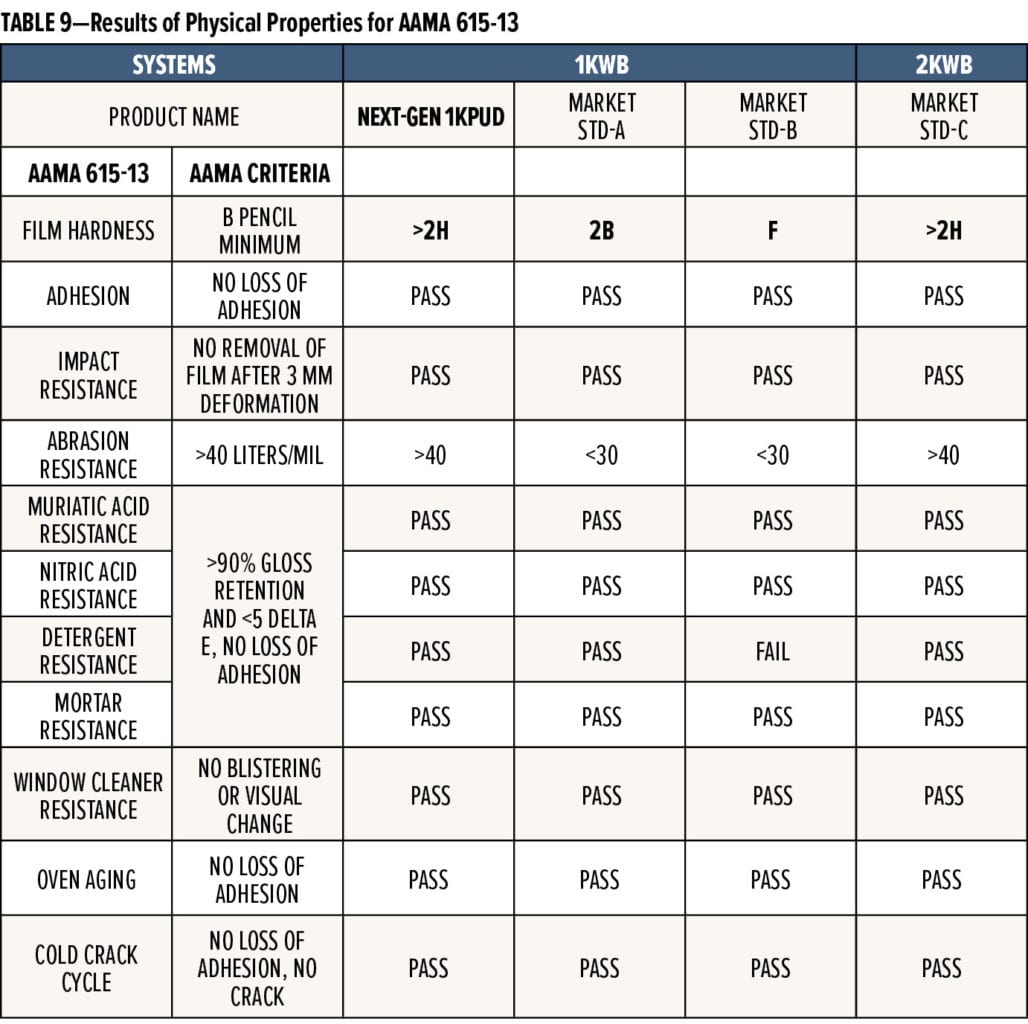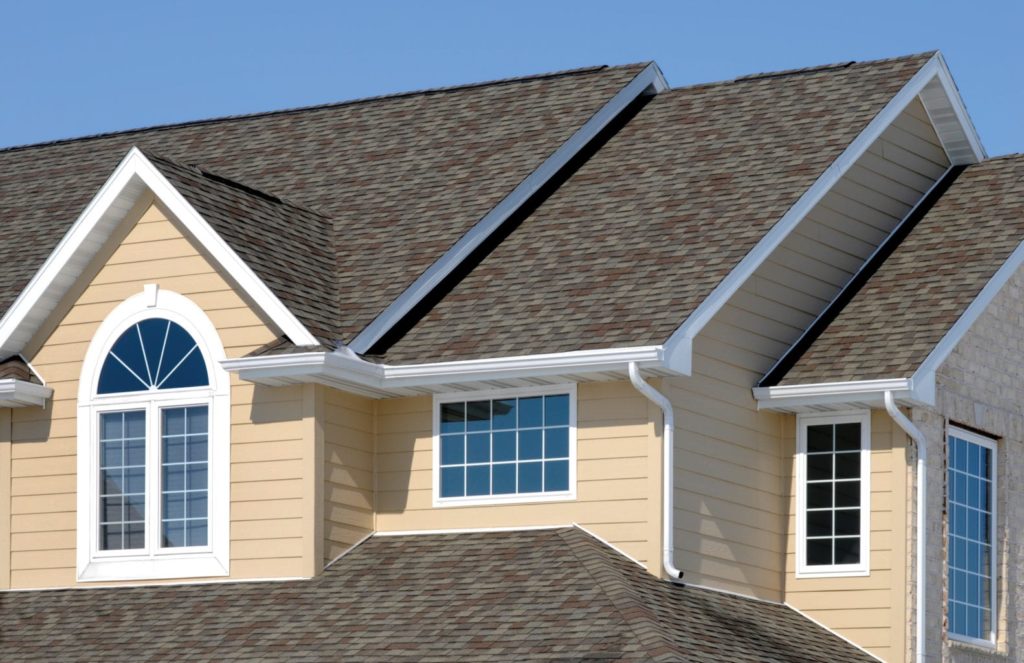By Makoto Nakao, Covestro LLC, USA
Introduction
Two-component waterborne polyurethane (2KWB PU) coatings have been recognized as coatings with excellent performance properties, and they are used in a wide variety of applications.1 However, they require the introduction of a curing agent as a second component to provide the crosslinking needed to enhance coating performance. Several challenges for 2KWB coatings are well known, including limited pot life, increased waste, potential risk for mixing failure, and additional process steps before application. Therefore, in certain markets, paint formulators continue to look for one-component waterborne (1KWB) coatings that perform comparably to 2KWB coatings; for example, coatings for the residential vinyl window market. Vinyl windows represent more than 70% of windows sold in the United States residential window market2 and nearly all of them are white in color. Consumers are demanding more color options and, to meet that demand, window manufacturers are painting more and more windows today. Currently, 2KWB coatings are the market standard, but window manufacturers and applicators are seeking high-performance 1KWB coatings that are easy to apply and provide comparable performance to the 2KWB coatings being used today. This article discusses the physical properties, as defined in American Architectural Manufacturers Association (AAMA) 615-13 specification,3 of a newly developed 1KPUR dispersion (hereinafter called “Next-gen 1KPUD”) that demonstrates comparable performance properties to 2KWB coatings used to paint residential vinyl windows today.
Experimental
To increase the performance of a 1KWB PU to the level of a 2KWB PU, an intensive development program was undertaken. Its goal was to develop a 1KWB PU with higher film hardness (e.g., >2H pencil gouge hardness) and with superior chemical resistance (e.g., detergent, nitric acid, and mortar). The study examined various kinds of high molecular weight polyol, different isocyanate monomer, various levels of hard block content, chain extension, neutralization, and solubilizing agents.
The development program succeeded, identifying a 1KWB PU dispersion with comparable performance to a 2KWB PU. The novel 1KWB PU dispersion, Next-gen 1KPUD, was synthesized using a prepolymer mixing process.4 Key properties of this PUD are listed in Table 1.

Physical Properties Comparison with High-Performance PUD and 2KWB PU System
Physical properties of the Next-gen 1KPUD were compared with commercially available high-performance PUDs and 2KWB PU systems. To that end, each of the PUDs and 2KWB PU systems was formulated as clear to avoid effects from other paint ingredients. Characteristics of high-performance PUDs and 2KWB PU systems used in this study are compiled in Table 2.

All systems were drawn down on glass and chromated aluminum panels at a wet-film thickness of 5 mils. Panels were dried at ambient conditions. Aside from dry times, all testing was conducted after a seven-day rest at ambient conditions. Dry times were measured by a dry-time recorder (DT-5040) manufactured by the Paul N. Gardner Co., Inc. For assessing film hardness, pendulum hardness was measured by a pendulum damping tester (Model 299/300) manufactured by Erichsen GmbH & Co. KG. Chemical resistance was measured by a spot test of the indicated chemical on glass. Stain resistance was also measured by a spot test for the indicated period. Humidity resistance was measured by exposing the film to 38°C at 100% relative humidity (RH) for 168 h and assessing for blisters.
Physical Properties for American Architectural Manufacturer Association 615-13 Performance Evaluation
Physical properties for American Architectural Manufacturer Association (AAMA) 615-13 of paint formulated with the Next-gen 1KPUD were compared to three different commercially available paints for vinyl windows. Two of them were 1KWB systems and the other was a 2KWB system. Physical property testing on each system was conducted according to AAMA 615-13 specifications. Table 3 shows a summary of all tests that were conducted. All systems were spray applied on PVC panels at a target dry-film thickness of 1.5 mils. All panels were initially wiped with acetone prior to coating application for performance testing.

Panels were allowed to flash dry at ambient conditions and dried at 50°C for 10 min. All testing was conducted after an additional seven-day rest at ambient temperature. Table 4 shows a generic formulation used as the base formulation for this study.

Accelerated Weathering
To assess the weathering performance of the paint formulated with the Next-gen 1KPUD, we compared it to a paint formulated with commercially available PUDs and 2KWB PU. Two studies were performed. Initially, the Next-gen 1KPUD and the commercially available PUDs (PUD-A and PUD-D) were compared using a clear formulation containing UVA and HALS. Secondly, the Next-gen 1KPUD was formulated into a white pigmented 1KWB PU coating and compared to a white pigmented 2KWB PU coating. Table 5 shows these white pigmented formulations used as the base formulation.

All systems were spray applied on chromated aluminum panels at a target dry-film thickness of 1.5 mils. Panels were allowed to flash dry at ambient conditions and then dried at 50°C for 10 min. Testing began after an additional seven-day rest at ambient temperature. The accelerated weathering tests were performed in a Xenon arc Weather-Ometer Ci-65 (Atlas Material Testing Technology, USA) according to ASTM D6695 (Cycle 1) and in a QUV/se (Q-Lab Corporation, USA) according to ASTM D4587 (Cycle 2). Gloss retention and color retention were measured for a total time of 2,000 h. Gloss retention was determined using a gloss meter (Micro-TRIgloss) manufactured by BYK Gardner Corp., and Delta E was determined using a spectrophotometer (Color i7) manufactured by X-Rite, Inc., as described in ASTM D 2244.
Results And Discussion
Physical Properties Comparison with High-Performance PUD and 2KWB PU
Physical properties of the Next-gen 1KPUD were compared to commercially available 1K PUDs and 2KWB PU systems. The results of chemical resistance and stain resistance testing are summarized in Table 6. As compared with commercially available 1K PUDs, the Next-gen 1KPUD showed superior chemical and stain resistance. It outperformed even PUD-D, a polycarbonate-based resin, known for high hardness and physical performance. Furthermore, its chemical and solvent resistance matched even those of the crosslinked 2KWB PU coating (PAC-A+PIC-B).

Fast-drying properties and film hardness development are required at most coating applicators to ensure high productivity; therefore, each formulation’s dry time and König pendulum hardness development were evaluated. These results are summarized in Table 7. The Next-gen 1KPUD showed the fastest dry-hard time of all systems tested. This result is consistent with the PUD’s higher Tg (Table 2) and its high molecular weight polyol in its backbone. The 2KWB systems, which rely on the chemical reaction between its isocyanate and polyol components, showed expectedly slow dry times at an ambient drying condition.

Humidity resistance is another key physical property in understanding the degradation of coatings due to water. To assess water resistance, blister formation on the film was measured after exposure to moisture. The result is summarized in Table 8. PUDs based on polycarbonate diols are known to have good water resistance due to better hydrolytic stability. The Next-gen 1KPUD, even though it is not polycarbonate-based, matched the humidity resistance of the polycarbonate-based PUD that was tested, PUD-D. It even outperformed the two 2KWB PU systems that were evaluated.

Physical Properties for AAMA 615-13 Performance Evaluation
Since the Next-gen 1KPUD showed better physical performance than different types of commercially available 1K PUDs and matched the performance of the 2KWB systems during our initial study, the testing standards were increased. A brown pigmented 1KWB coating formulated with the Next-gen 1KPUD was compared with three different commercial vinyl window paints under the stringent AAMA 615-13 testing protocol. The results of physical property testing according to AAMA 615-13 are summarized in Table 9. Overall, the paint formulated with the Next-gen 1KPUD passed all AAMA 615-13 physical property requirements and performed just as well as the 2KWB commercial system.

The most noteworthy result of the coating formulated with the Next-gen 1KPUD is its high pencil gouge hardness. The need for increased film hardness compared to the AAMA specification (min. B) is highly desirable by coatings applicators and window manufacturers for vinyl window applications. They would like to avoid potential damage during packaging, transportation, and installation of windows on site. As expected, the commercial 2KWB paint had much higher pencil hardness than other commercial 1KWB paints. The 2KWB PU’s crosslinked structure imparts toughness to the film which a 1KWB PU lacks. Surprisingly, the Next-gen 1KPUD matched the film hardness of the 2KWB system, while also lacking this crosslinked structure.
Accelerated Weathering Performance
To understand long-term weathering performance, the Next-gen 1KPUD was compared to both commercially available, high-performance 1K PUDs and a 2KWB PU system using two protocols. First, to compare the Next-gen 1KPUD’s weathering to commercially available, high-performance 1K PUDs, the films were exposed to QUV-A following ASTM D4587 C2. The results are shown in Figure 1. The Next-gen 1KPUD maintained 100% gloss retention after 2000 h, while PUD-D (polycarbonate-based PUD) started to reduce gloss after 1000 h and PUD-A (polyester-based PUD) started to reduce gloss even sooner, after only 750 h.

Second, to compare the Next-gen 1KPUD’s weathering performance to a 2KWB PU coating, it was formulated with a white pigment to match the 2KWB PU coating. The results of the Xenon arc weathering testing are summarized in Figure 2.

A white pigmented coating formulated with the Next-gen 1KPUD weathered better than the 2KWB PU coating. The formulated Next-gen 1KPUD coating retained its gloss and color beyond 2000 h, while the 2KWB PU coating gradually reduced gloss after just 250 h. Overall, the Next-gen 1KPUD had better weathering performance than both the high-performance commercial PUDs and the 2KWB PU coating that was evaluated.
Conclusions
The Next-gen 1K PUD, a novel 1K PU dispersion, outperformed commercially available 1K PUDs by exceeding their chemical and stain resistance and matched even the performance of crosslinked 2KWB coatings. Moreover, the Next-gen 1KPUD demonstrated faster dry times than the 2KWB coatings, which will increase productivity during the coating application. A coating formulated with the Next-gen 1KPUD passed all the AAMA 615-13 physical performance requirements. Further, its film hardness matched that of a crosslinked 2KWB coating. Finally, accelerated weathering tests under QUV-A and Xenon arc exposure showed that a coating formulated with Next-gen 1KPUD will outperform commercially available 1K PUDs and a 2KWB coating that were evaluated.
Acknowledgments
The author would like to acknowledge the contributions of Lyubov Gindin, Stephanie Goldfein, Natalee Smith, Tom Durkin, and Phil Jones to this paper and thank Ron Konitsney, Tina Kasardo, and Derick Henderson for preparing paint formulations and conducting the studies described in this article.
References
- Wicks, Z.W., Wicks, D.A., and Rosthauser, J.W., “Two Package Waterborne Urethane Systems,” Prog. Org. Coat., 44, 161-183 (2002).
- American Architectural Manufacturers Association (AAMA) 2016/2017 U.S. National Statistical Review and Forecast, March 2017.
- American Architectural Manufacturers Association (AAMA) 615-13 Voluntary Specification, Performance Requirements and Test Procedures for Superior Performing Organic Coatings on Plastic Profiles.
- Dieterich, D., “Aqueous Emulsions, Dispersions and Solutions of Polyurethanes; Synthesis and Properties,” Prog. Org. Coat., 9, 281-340 (1981).
Presented at the American Coatings Conference, April 9–11, 2018, in Indianapolis, IN.
CoatingsTech | Vol. 16, No. 2 | February 2019
